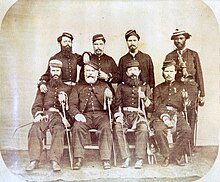The military ranks of the Empire of Brazil were a rank system used by the Armed Forces of the Empire of Brazil.

Imperial army
editThe rank insignia of the Estado-Maior General (General/Flag officers) were established by an Imperial Decree of 7 October 1823. They bore the leaves of an Oak-tree, similar to the ranks of the Portuguese Army of the early 1800s. The ranks for the Senior and Junior Officers were the same throughout Pedro II's reign.[1]
Promotion
editIn 1850, a law regulating the Promotion of officers in the Imperial Brazilian Army was approved. According to this legislation, to become an officer, one must have spent at least two years as a praça, and be at least 18 years old. This meant that to become an Alferes, equivalent to a 2º Lieutenant, one had to be either a Sergeant or a Cadet with service time at lower rankings, not to mention the students from the Escola Militar whose entrance to officership was handled by a separate legislation. To move up the rankings to Captain, the officer must have spent two years serving as a Tenente and two years as an Alferes. Promotion off Captain, after three years serving as one, would be as such: half of the officers promoted from Major to Coronel would be due to their service time, and the other for their accomplishments. On the other hand, promotion to the General Officers would only be granted for the accomplishments of the officer.[2]
For the Praças however, to achieve promotion was based on whether the praça had volunteered or had been conscripted. José Iran Ribeiro, from the Federal University of Santa Maria, found out that, from a group of 15 volunteers, 9 had risen up to become sergeants 6 of them before reaching 20 years of age. For 16 conscripts, promotion to sergeant was achieved by 5 of them, 3 of them after their 25th birthday.[3]
Paraguayan war
editOfficers
edit| Rank group | General / flag officers | Senior officers | Junior officers | |||||||||||||||||||||
|---|---|---|---|---|---|---|---|---|---|---|---|---|---|---|---|---|---|---|---|---|---|---|---|---|
| Epaulettes | ||||||||||||||||||||||||
| Sleeve rank insignia | ||||||||||||||||||||||||
| Name[4][5][6] | Marechal de Exército | Tenente-general | Marechal de campo | Brigadeiro | Coronel | Tenente-coronel | Major | Capitão | Tenente | Alferes | Alferes-aluno | |||||||||||||
Praças
edit| Rank group | Senior NCOs | Junior NCOs | Enlisted | |||||||||||||||||||||||||||||||||
|---|---|---|---|---|---|---|---|---|---|---|---|---|---|---|---|---|---|---|---|---|---|---|---|---|---|---|---|---|---|---|---|---|---|---|---|---|
| Sleeve rank insignia[4][7] | ||||||||||||||||||||||||||||||||||||
| Primeiro-sargento | Segundo-sargento | Furriel | Cabo | Anspeçada | Soldado | |||||||||||||||||||||||||||||||
National Guard
edit1831
editOfficers
edit| Rank group | General / flag officers | Senior officers | Junior officers | |||||||||||||||||||||
|---|---|---|---|---|---|---|---|---|---|---|---|---|---|---|---|---|---|---|---|---|---|---|---|---|
| Collar Rank insignia | ||||||||||||||||||||||||
| Name[8][9] | Comandante Superior | Coronel Chefe de Legião | Tenente-coronel | Sargento-Major | Capitão | Tenente | Alferes | |||||||||||||||||
Praças
edit| Rank group | Senior NCOs | Junior NCOs | Enlisted | |||||||||||||||||||||||||||||||||
|---|---|---|---|---|---|---|---|---|---|---|---|---|---|---|---|---|---|---|---|---|---|---|---|---|---|---|---|---|---|---|---|---|---|---|---|---|
| Collar Rank insignia | ||||||||||||||||||||||||||||||||||||
| Sleeve rank insignia | ||||||||||||||||||||||||||||||||||||
| Names[8] | Primeiro-sargento | Segundo-sargento | Furriel | Cabo | ||||||||||||||||||||||||||||||||
References
edit- ^ Barroso 1922, pp. 30, 47.
- ^ "LEI Nº 585, DE 6 DE SETEMBRO DE 1850" [LAW Nº 585, OF SEPTEMBER 6TH 1850]. www2.camara.leg.br (in Portuguese). 1850. Retrieved 2023-12-31.
- ^ Ribeiro, José Iran (2010). "Nem Oficiais, Nem Soldados: Perfis Dos Militares De Patentes intermediárias Do Exército Imperial Brasileiro Durante a Guerra Dos Farrapos". Locus: Revista De História (in Portuguese). 15 (2).
- ^ a b Barroso 1938.
- ^ "Diário das leis – Approva o Regulamento para execução da Lei Nº 585 de 6 de Setembro de 1850" [Diary of laws – Approves the Regulation for the execution of Law Nº 585 of September 6, 1850.]. www.diariodasleis.com.br (in Brazilian Portuguese). Retrieved 2023-04-22.
- ^ "Diário das leis – Providencia a respeito das habilitações, classificação, numero, e uniforme dos Alferes alumnos do Exercito" [Diary of laws – Provides information about the qualifications, classification, number, and uniform of Army student ensigns.]. www.diariodasleis.com.br (in Brazilian Portuguese). Retrieved 2023-04-22.
- ^ Castro, Celso (2012). Exército e nação: estudos sobre a história do exército brasileiro (in Brazilian Portuguese). p. 14.
- ^ a b Fernandes 1849, p. 65.
- ^ Barroso 1922, pp. 79.
Bibliography
edit- Barroso, Gustavo (1922). Uniformes Do Exército Brasileiro [Uniforms of the Brazilian Army] (in Brazilian Portuguese).
- Barroso, Gustavo (1938). "História Militar do Brasil" [Military History of Brazil] (in Brazilian Portuguese).
- Fernandes, Antonio Manoel (1849). Indice chronologico, explicativo e remissivo da legislação brasileira desde 1822 até 1848 : precedido cada anno, além do reinado, que a elle presidio, dos nomes dos ministros, que dirigirão as respectivas repartições, e cada legislatura dos nomes dos senadores, e deputados, que nella tomarão parte [Chronological, explanatory and remissive index of Brazilian legislation from 1822 to 1848: preceded each year, in addition to the reign, which he presided over, the names of ministers, who will direct the respective departments, and each legislature of the names of senators, and deputies, who will take part in it] (in Brazilian Portuguese). Vol. 2. p. 65.